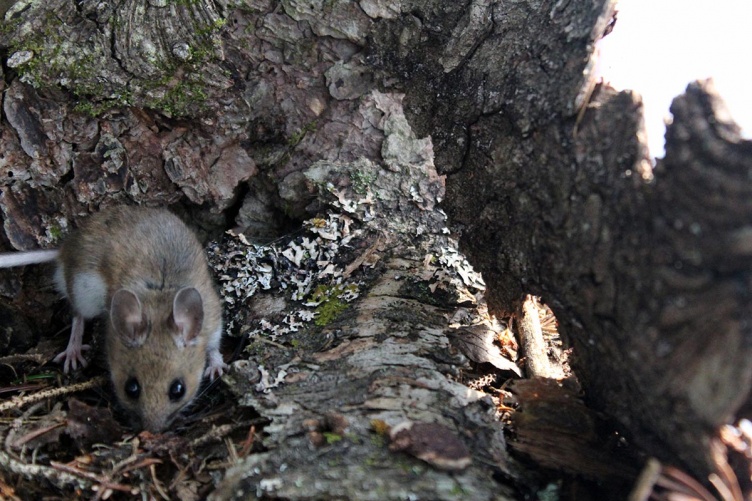
Woodland animals such as mice play an essential role in keeping forests healthy and thriving.

Robust forest growth and regeneration are critical to ensuring economic sustainability of New Hampshire's timber industry. And it is the tiniest of woodland animals that play an essential role in keeping forests healthy and thriving, according to new research from the New Hampshire Agricultural Experiment Station.
Ryan Stephens, lead researcher of the experiment station-funded project, explained that in New England, all trees form a mutually beneficial relationship with either arbuscular mycorrhizal (AM) or ectomycorrhizal (ECM) fungi, which produce fruiting bodies that occur below ground (truffles) or above ground on the forest floor (mushrooms). These fungi colonize plant roots and increase nutrient and water uptake of trees. In exchange, trees provide mycorrhizal fungi with sugars. Many tree seedling require colonization by mycorrhizal fungi for survival and growth.
Since different fungal species enhance plant growth and fitness during different seasons and under different environmental conditions, maintaining diverse fungal communities is vital for forest composition and resilience to drought. However, following timber harvests, fungal diversity is reduced when host trees die. This results in lower inoculation rates of tree seedlings in harvested areas, which can ultimately hinder forest regeneration. What helps fungal spores find their way back to locations where new stands of tree are growing?
“Small mammals such as mice, voles, chipmunks, and shrews play an important ecological role by eating truffles and mushrooms and dispersing spores to new areas. This dispersal is particularly important as trees regenerate following disturbances such as timber harvests,” Stephens said.
To effectively disperse fungal spores, small mammals must scatter spores of the correct type of fungi (AM or ECM) in sufficient quantities and to appropriate locations where tree seedlings are regenerating. Determining the role of small mammals in dispersing these fungal spores is key to understanding how to maintain these important mammal-fungal interactions in managed forest systems.
Researchers found that small mammals such as rodents and shrews were adept at distributing mycorrhizal fungi, with some mammals disbursing AM fungi and other mammals distributing ECM fungi. However, more mammals ate AM fungi, making dispersal of AM spores more resilient to changes in the mammal community than spores of ECM fungi, which were primarily only dispersed by one species, the southern red-backed vole.
In addition, mammals varied from having no associations with microhabitats--a small area that differs from the surrounding habitat--to being associated with a variety of different forest conditions, such as such as the presence of downed wood or patches of vegetation and a high density of young trees.
“By using management strategies that retain downed woody material and existing patches of vegetation, which are important habitat for small mammals, forest managers can help maintain small mammals as they are important dispersers of mycorrhizal fungi following timber harvesting. Ultimately, such practices may help maintain healthy regenerating forests,” Stephens said.
This research is published in the journal Functional Ecology (DOI: 10.1111/1365-2435.13855). In addition to postdoctoral researcher Stephens, researchers include experiment station scientist Serita Frey, professor of natural resources and the environment at UNH; Anthony D’Amato, professor of silviculture and applied forest ecology at the University of Vermont; and experiment station scientist Rebecca Rowe, associate professor of natural resources and the environment at UNH.
This material is based upon work supported by the NH Agricultural Experiment Station, through joint funding of the National Institute of Food and Agriculture, U.S. Department of Agriculture, and the state of New Hampshire. Additional support was provided by the Department of Interior Northeast Climate Adaptation Science Center, U.S. Forest Service Northern Research Station, and Dartmouth College Woodlands.
Founded in 1887, the NH Agricultural Experiment Station at the UNH College of Life Sciences and Agriculture is UNH’s first research center and an elemental component of New Hampshire's land-grant university heritage and mission. We steward federal and state funding, including support from the USDA National Institute of Food and Agriculture, to provide unbiased and objective research concerning diverse aspects of sustainable agriculture and foods, aquaculture, forest management, and related wildlife, natural resources, and rural community topics. We maintain the Woodman and Kingman agronomy and horticultural research farms, the Macfarlane Research Greenhouses, the Fairchild Dairy Teaching and Research Center, and the Organic Dairy Research Farm. Additional properties also provide forage, forests, and woodlands in direct support to research, teaching, and outreach.
-
Written By:
Lori Tyler Gula, PhD | NH Agricultural Experiment Station | lori.gula@unh.edu | 603-862-1452
















































